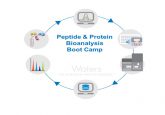6. What are the biggest challenges for adoption of HRMS in your field?

Bertrand Rochat: “In clinical analysis, the main requests are from medical doctors and concern targeted and quantitative analyses of a few compounds. In this context, HRMS does not perform better than QQQ–MS and, therefore, there would be no advantages to shift! But HRMS can bring various unique analyses that can be useful to the patients and to clinical research projects. These additional determinations could not be undertaken with QQQ–MS. They are clinical and quantitative proteomics, metabolomics etc. The capabilities of HRMS have to be taught to medical doctors, clinicians and bioanalysts. Again, the pioneers will show the way…”
Diego Cortes: “In general, there are several areas to be addressed before LC–HRMS could be more widely adopted in regulated bioanalysis; some of these are technology-related while some are related to regulatory compliance.
While significant strides have been made to improve the sensitivity of HRMS platforms, it is generally accepted that QQQ instruments operating in SRM mode have superior sensitivity. While it is true that HRMS offers clear value to quantitative bioanalysis, driving sensitivity through selectivity, it would be especially advantageous if sensitivity can be improved in future HRMS platforms for large molecule intact quantitation.
Software continues to be a major limitation. Better software packages are needed that can proficiently process the data for both qualitative and quantitative applications and be fully validated to regulatory standards. HRMS has traditionally been applied for qualitative/discovery work, and as a result, the software has been designed mostly for research purposes. In order to facilitate uptake on quantitative bioanalysis, some of the software systems need to be re-engineered for user-friendliness and compliance in routine applications.
There are also regulatory hurdles to using some of the features of HRMS in regulated bioanalysis. The idea of post-acquisition data mining is concerning, both in regard to using an assay to measure something that was not part of the original method validation and in terms of patient informed consent and study protocols governing the use of clinical samples.”
Graeme Clark: “The biggest challenges are addressing the concerns around regulatory acceptance of data. In addition, due to the much larger file size associated with HRMS, data management (back-up, archiving etc.) needs to be looked at.”
Ian Edwards: “As the technology becomes more accessible to non-experts, adoption will become more commonplace for large molecule bioanalysis – especially to answer both qualitative and quantitative questions, such as quantification alongside characterization of in vivo biotransformation. For emerging applications like intact protein quantification, the biggest barrier to adoption might not be the technology itself but a combination of new developments in sample preparation and chromatography to achieve the required quantitative performance, not to mention informatics solutions.”
Scott Summerfield: “Traditionally, the biggest challenges to adoption have been sensitivity, the higher cost for a high-end HRMS and our level of comfort with the quadrupole platform (e.g. ‘better the devil you know than the devil you don’t’).”
Timothy Garrett: “My field is dominated by HRMS so this is not a limitation. The biggest challenge is informatics.”






